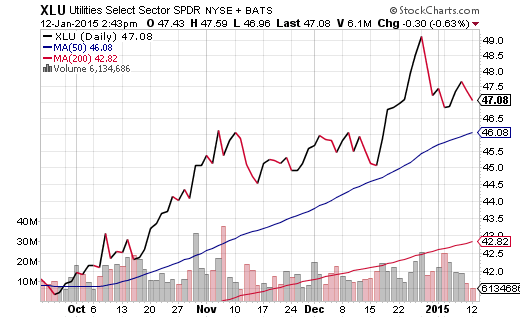With the exception of the last few years, most economic data has been entirely unimpressive. Yet bad news for the economy still meant good news for market-based securities. Why? The Federal Reserve kept renewing its bond purchasing program as well as its zero percent rate policy, providing low rates for corporate debt issuance and stock buybacks. When the bad news on the economy began sounding more upbeat – when the economic story morphed into good news – the backdrop still remained positive for stocks. How so? Well, an economy that can support itself without rate manipulation by the central bank of the United States must be self-sustaining, right? Let the good times roll on!
Perhaps unfortunately, investing actually involves risk. Choosing to become a shareholder does not imply that gains are simply a matter of holding long enough to realize one’s good fortune. It follows that, in a manner that cannot be described as predictable, good economic data can become bad news for the markets (e.g., “The Fed will be forced to raise rates sooner because 2014 job growth has been the strongest since 1999.”). Similarly, bad news can start dragging on stocks (e.g., “Wage growth at an annualized 1.7% is far inferior to growth before the Great Recession, and falling short on cost-of-living increases.”)
In truth, one cannot readily anticipate how market-based securities will react to a constant stream of information. Understanding this, should one always endeavor to buy the stock dips? Conversely, should one sell stock assets when broad market benchmarks have fallen a certain percentage from respective high points?
There are no easy answers here. If one professes to favor buying the sell-offs, one would have difficulty succeeding in years when 10% corrections do not occur, and the dips are a meager 3%-5%. The same person would likely be eviscerated by 40%-50% bear markets, as there would be little capital left to buy during the horrific descent. On the other hand, selling assets at 7%, 8% or 10% off a high-water mark could leave an investor floundering to determine how to re-engage, particularly in the “V-shaped” turnarounds of 2013 and 2014.
My answer is straightforward. Before you purchase any asset at any price, you must understand the precise conditions under which you would sell that asset. For example, let’s say an investor believed in January of last year (2014) that SPDR Energy Select Sector Fund (ARCA:XLE) would appreciate in value due to expected economic improvements in Europe as well as escalating tensions in oil-producing regions. This investor buys 400 shares of XLE for $34,000 at $85 per share with the knowledge that he/she would sell the exchange-traded fund 10% off the highest point it reaches in the time of ownership – also known as a “trailing stop-loss” – or if the fund falls below a 200-day moving average, whichever comes last.

In this particular example, XLE breached its 200-day trendline as well as fell 10% from its peak at roughly the same time; that is, the investor would have sold for a small gain for $90 in September. Granted, the investment could have turned around on the day of the sale and gone right back to new highs. Yet the reason one sells for a big gain, small gain or small loss is to protect against a big loss. Here, further deterioration has occurred.
Another overlooked facet in the decision to take a big gain, small gain or small loss is the reality that the capital may be redeployed in a less risky, more productive asset. Let us assume the investor wants to reduce cyclical sector risk in his/her portfolio, and rotates the $36,000 ($34,000 + $2,000 gain) into the lower beta volatility world of utilities. The erroneous assumption by those who do not value stop-limit loss orders or long-term trendlines is that the “sell” event results in missed opportunity. On the contrary, rotating into XLU provided greater opportunity with less portfolio volatility.

Equally worthy of note, suppose the investor simply wanted to lower stock risk by redeploying the capital into intermediate-term treasury bonds. He/she would have profited with an asset allocation shift into iShares Barclays 7-10 Year Treasury Bond (ARCA:IEF)
Are stop-limit loss orders perfect? Far from it. Is the 200-day moving average sacrosanct? Maybe to the technical analyst, but otherwise, it has plenty of flaws as well. The reason a long-time money manager like myself uses these tools is because I recognize the emotional intelligence of maintaining one’s discipline and the mathematical sensibility of insuring against catastrophe. Applying insurance principles to the investing process – no matter how one chooses to do it (e.g., stops, trendlines, put options, hedges, etc.) – is more critical to one’s financial well-being than finding the next “biotech biggie.”
I will add here that I believe so strongly in the necessity of insurance, I partnered with FTSE-Russell to create the FTSE Custom Multi-Stock Hedge Index. Some are calling it the “MASH” Index. Indeed, if a bearish downturn were to occur, the components of this index would likely bolster one’s portfolio’s health. The index is comprised of assets that have a history of advancing when stocks struggle – U.S. bonds, foreign sovereign debt, currencies, Gold – yet the index has the potential to perform irrespective of how well stocks perform. You can learn more about multi-asset stock hedging here.
Disclosure: Gary Gordon, MS, CFP is the president of Pacific Park Financial, Inc., a Registered Investment Adviser with the SEC. Gary Gordon, Pacific Park Financial, Inc, and/or its clients may hold positions in the ETFs, mutual funds, and/or any investment asset mentioned above. The commentary does not constitute individualized investment advice. The opinions offered herein are not personalized recommendations to buy, sell or hold securities. At times, issuers of exchange-traded products compensate Pacific Park Financial, Inc. or its subsidiaries for advertising at the ETF Expert web site. ETF Expert content is created independently of any advertising relationships.

